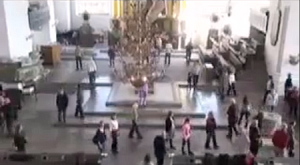You are currently browsing the category archive for the ‘Sound Healing’ category.
Back in 2012, I interviewed the recording artist who would come to be known as 33 Bowls after his 2012 recording of the same name. He had just recorded his initial collection of 33 bowls he got from Bodhisattva in the 2009-2011 time frame, and went on to do two of the most powerful recordings of singing bowls to date with them. Now, he has consigned the last of this remarkable collection back to us to find a new home, and we’re checking in with him again.
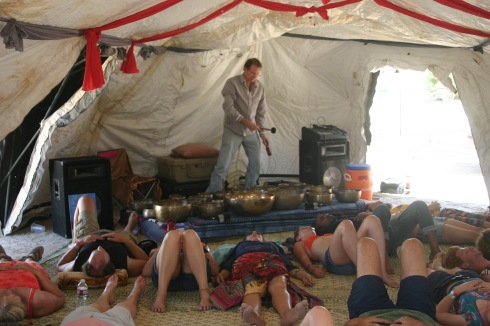
Shakti: I remember telling you that I didn’t resonate with Breathe the way I did with 33 Bowls. When you asked me why, I confessed that I didn’t really know because I kept falling asleep a few minutes into the recording.
33: (laughs) The intention was to unwind stress. Your body reacted by going into deep relaxation, which you obviously needed.
Shakti: How did you become attracted to working with matched pairs?
33: It happened synchronistically – it was amazing to me to find bowls from different centuries that were tuned so close to each other. The unique sound of the recording is at least part from the closely matched pairs – they beat against each other like a well-tuned piano. The subtleties of the strings will weave back and forth with each other, at the same rate as relaxed breathing, a contented heart beat or an ocean wave. You do not get this effect with a single bowl.
Shakti: How did you develop that approach?
33: Familiar with healing modalities such biofeedback and, deep body work, I got the same feeling. The sounds felt similar to the feelings in those modalities, and tend to induce similar states.
Shakti: How did you update your recording technology in Breathe from 33 Bowls?
33: The microphone technique was different. I designed 33 Bowls to put the listener in the room with the singing bowls. In the sequel, Breathe, I changed the technique to envelope you, the listener in the sound of the bowls. Listen to Breathe with headphones for a particularly juicy experience.
There’s something known as “First principle”. One of the first principles I followed in 33 Bowls and Breathe was to minimize the time smear in the entire recording chain. This means reducing the unwanted effects that are common in most recording equipment, in order to maintain the integrity of the nuances and subtle textures of the sound.
Shakti: What did you like about playing the bowls live?
33: Facilitating people becoming more chilled out and contented. I did most of these events in 2012 through 2016. Several years at the Vibration Station at the Joshua Tree Music Festival, (2014 pictured). Lightning in a Bottle, Synchronicity Symposium, Glen Muse in Ojai, the Integraton and Furst World in Joshua Tree, many private living room concerts.
Shakti: Why are you letting them go?
33: Recordings and events happen when they happen. I’ve said what I had to say. I’m moving overseas and I don’t want to put these bowls in storage. I want them to be used and enjoyed. Ever seen a buddhist sand mandala? It symbolizes the ephemeral nature of physicality, and the eternal nature of the experience.
From 2012:
Many of our customers at Bodhisattva are destined to share their singing bowls with their communities. But few have put more research and energy into immortalizing these vessels of peace than our customer who is simply known as 33 Bowls. A lanky, razor sharp Californian, he amassed a world class collection of singing bowls in quarter tone tuning (close to Solfeggio) in a breathless year and a half, over the course of maybe four or five collections. Then he recorded. 33 Bowls, in our opinion, picks up where One Hand Clapping, the first digital recording of Tibetan Bowls and nature sounds, left off. That torch has been passed. Thank you, 33 Bowls, for lighting up the world with it.
If anything, 33 Bowls is a confluence of ancient bronze technologies and – as of today – state of the art high resolution recording technology. Tell us about your technical and artistic background that brought these technologies together.
I am in awe of the masters of constructed/studio soundscape, Thomas Dolby, the late Hector Zazou, Allan Parsons of Pink Floyd, Delerium, Michael Brook, to name a few; and yet the challenge of creating, capturing, or really facilitating a natural soundscape — antique musical instruments in a live acoustic space — is/was what intrigued me.
When younger, I hung out more with nerds and musicians than with motorheads or jocks, and somehow managed to avoid serious hearing damage. Nuance and subtlety in music and sound have always been fascinating to me, and have been an attraction as to how we hear, and how to reproduce or re-create the experience in recordings.
I have both a technical and Artistic background, and firmly believe in integrating both hemispheres. I think I innately understood electronics before I could speak! For many years I was with Laserium, combining visuals of bright clear laser light with music in Planetarium domes, and facilitated thousands of mind expanding trips without partaking in any hallucinogens. Later, I was part of an analog chip design group, and left the words “Don’t Panic” from Hitchhiker’s Guide to the Galaxy in micron sized letters on a chip that is part of the Internet backbone.
What is ongaku?
There is a word used in audiophile circles: “ongaku” which means soul or essence of sound and music. That also describes the presence of live un-amplified music in a good acoustic space that is felt as much as it is heard. Most recordings and systems fall short, one can easily hear from the next room if it is live or reproduced, regardless of what a famous tape company claimed in ’70s and ’80s ad campaigns.
What attracted you to the bowls initially? And what inspired you to record them?
While studying massage with the many hours of practice, I put together some remixes for massage music that were popular with fellow practitioners and recipients, but the complexity and cost of multiple copyrights prohibited general release. The call for something more fluid, natural, timeless, ethereal, and original was sparked. So, 33 Bowls started out as a couple of questions: “what if” and “wouldn’t it be nice to” in the context of Singing Bowls. It is also a story which does not have a place in the realm of strict left brained linear planning: it was a mind blowing experience of serendipity or synchronicity to piece together a set of pitch matched antique metal Singing Bowls in a relatively short period of time once the intention was set and released or let go of if I may end a sentence with a preposition. The pitch is not western A440, it turns out to be closely aligned to an older scale which is harmonically related to terrestrial and cosmic cycles, that is referred to (and unfortunately hyped) as the Solfeggio Scale, but the ratios are harmonious to western ears. It is my contention that as we, through our ancestors, have heard these sounds for centuries, and there is something innately familiar, even sacred, about the sound of antique musical instruments tuned to this scale.
What attracted you to the antique singing bowls, as opposed to Crystal bowls?
Although the more modern crystal or glass Singing Bowls can sound quite nice, particularly when accompanied by female voice, and are easier to record as they are considerably louder, the resonances are less complex. It is also arguable whether they are truly crystalline, as they are crafted as a spun amorphous slurry at high temperatures which gives them their close to perfect radial symmetry. Ironically it is the slight imperfections in metal Singing Bowls that add the complex harmonics and sub harmonic beats. Take that as a metaphor about perfect imperfection. Antique metal Singing Bowls in particular can have a rich, sonorous, smooth sound quality. But the complex harmonies and particularly sub-harmonic beats that both match and induce deep, meditative states in the brain, mind, heart, and gut are what appealed to me.
Why 33 Bowls?
I was playing live for a thanksgiving day yoga class, and the Yogi, counting the class attendees noticed there were 33 students there, and that there were 33 Singing Bowls. So the name became obvious.
Tell us about the Artwork.
The cover Artwork is from a painting in a private collection by a relatively obscure, modest, and very talented Artist. I wanted something that looked like the music of 33 Bowls feels, and this painting matched in a way that was instantly “it”. This is what the Artist had to say about the music that her painting matches: “It connects me back to something, an older language of sound that just resonates in a way that doesn’t even have words. Feels like I’m joining an ancestry, it doesn’t feel like my emotion…something that’s been dormant, becomes enlivened.” I specifically do not put my name or image on/in the album cover Artwork or liner notes, as it is about the music and not the musician, and certainly not about the musician’s ego.
The bowls are notoriously difficult to record. Tell us in general terms your approach to engineering the recordings. Were all the bowls recorded live?
Technology: I started off with the proverbial blank sheet of paper. There is no single facet or piece of equipment in the recording chain that makes the recordings sound the way they do. There is a gestalt or synergy of everything involved. None of it is “off the shelf”; all is either modified, custom, or built from scratch. The intention was/is to capture as much of the nuance as possible early on in the signal path. Once that is lost, it is “gone forever” and no amount of studio trickery can re-constitute the aliveness of the real thing. Particular attention was/is paid to minimizing time smear in each facet or component and the implementation of that component. There are a few unavoidable background noises of a live event, but it is close to what one would hear if relaxing in a room hearing the Singing Bowls live, with full ambience and presence. It is not a studio piece by piece creation, so the continuity of the live experience is there. On a reference system, 33 Bowls is the only recording of Singing Bowls that I am aware of that has consistently fooled a variety of listeners into thinking there was a live performance of Singing Bowls in the next room. The CD and high resolution 24 bit downloads provide the highest level of fidelity, but mp3 and iTunes versions sound surprisingly good, again as the recording started out early on with full nuance and resolution.
How do the bowls affect us? How does brainwave entrainment expand our consciousness? Tell us about your work with using bowls as bio feedback instruments.
I believe there is a poignant need for awakening, coherence, articulation, integration of complexity; and hope that music such as 33 Bowls contributes to that. Although statements like that do sound rather abstract, such phenomena provide an archetypal underpinning for “concrete” embodied experiences. They are not a luxury, they are essential for not only our survival, but our “thrival” as a species on this emerald earth. I also believe it is important for us to re-discover our innate embodied, yet environmentally interconnected wisdom and how it ties in with the flow of a bigger picture; whether we call it intuition or hunches, or listening to the heart, or splenic/sacral/plexus knowing.
There is a phrase that is popular to the point of being a cliche, but does have meaning: “holding the space”. Much, maybe most music is about communicating a message of sorts, usually emotional. 33 Bowls does not do that, it holds the space to facilitate and enhance whatever is present. What it is doing is providing a coherent, yet complex natural “signal” for the ears/brain/mind to entrain to and “drop” into a more relaxed, lower stress state of being. Our ears are not passive; they are active participants in sound, interacting with the environment in a way which leads to brain/mind entrainment with what we hear, whether it is shamanic drums, Singing Bowls, cacophonic city noise, or the breath and heartbeat of someone close to us.
Here’s something to try: while listening to Singing Bowls live or via a high resolution recording, notice the embodied sensation, physically, inside your ears. It may be subtle or it may be obvious, but there will be a sensation of the area inside your ears pulsing, or moving to the sub-harmonic beats. You may even notice background sounds modulating or phasing in and out inversely. That is the mechanism of brain/mind entrainment as your ears phase lock and entrain to sounds. Once you get it, Singing Bowls and possibly other sounds may never be quite the same again.
This is likely an evolutionary throwback of our physical ancestors by which our ears have an expanded dynamic range for greater sensitivity: predator and prey developed and favored an adaptive hearing ability while listening for each other in the context of background sounds; those that were more successful passed the epigenetics to future generations.
It is possible, even probable that temple meditation in ancient times was more than enhanced by the sounds of Singing Bowls through entrainment. Once one has consciously experienced a particular state, even if induced externally, it is possible to achieve it individually sans stimulation. The practice of Mindsight and the modern field of Interpersonal Neurobiology is confirming such a hypothesis. Compassion and empathy do naturally occur with expanded external and internal focus and concurrent integration.
I have heard from numerous healing practitioners of various modalities that their clients love 33 Bowls as background music, that it enhances the healing process. I do hold a special place in my heart for those who endeavor to make the world a better place one body/psyche at a time.
Your dedication to the artisans who made the bowls I found very moving. Do you get a sense of the bowls’ history? Do you get a sense of timelessness? Do you get a sense of their future?
Very much I get the perspective of standing on the shoulders of giants, the Artisans who crafted these Singing Bowls centuries ago; their focus, intention, timeless expression of beauty and beauty in expression. Hence the dedication of gratitude to them is included in the cover Artwork. Looking to the future, unless we figure out teleromes, the collection of Singing Bowls will likely outlast me as they have with their original Artisans. One benefit of the pandora’s box of modern technology is that many more can enjoy and benefit from the sounds of Singing Bowls, particularly if they are well recorded as described above.
How many downloads of 33 Bowls have you gotten so far? What other singing bowl projects are in the works?
Actually, with “just” word of mouth and zero advertising budget, 33 Bowls has been in the Amazon New Age downloads top ten for the past year. They seem to have a mind of their own! Sequels will be released when there is genuinely something worthwhile to say. I can say that the next release will segue with the end of “morning” to make a seamless extended session of 33 Bowls. Plus, maybe, something specifically for headphones. We shall see. For announcements, check back here or visit 33bowls.com.
Although she seems like a longtime customer, in fact I have only had the pleasure of knowing Nancy since June of ’12, when she made her first purchase of a few Master-quality bowls in quarter-tone tuning. She was on fire with enthusiasm for the bowls, and within a month, I had put together a Pentatonic Set for her based on the rim tones. Soon, she began exploring her set’s diatonic fundamentals in a Chakra-tuned scale in the 3rd octave, and another Universe opened up for her. Before long, we had put together a Pentatonic set of 3rd octave fundamentals to match her 5th octave Pentatonic rim set, so she could play tri-tone intervals between the two sets. We are still working on a Cycle of Fifths set to round out her collection.
It was fun to work with Nancy because she followed her own road harmonically; expanding her set intuitively, guided by her inner ear. But perhaps most gratifying of all was hearing about her visits to the Long Term Care Facility at Providence Valdez, and knowing she would share her singing bowls with the patients there. I am grateful to her for sharing the gift of sacred vibration with her community, and I’m inspired by her generosity. ~Shakti
.
Every Tuesday, I take a collection of my singing bowls from the Bodhisattva Trading Company to the Valdez Providence Hospital Long-term Care Facility in Valdez. Each Tuesday is a new experience, just as the rich tones and harmonics bring out constantly changing tonal moments.
Some Tuesdays, residents stay in bed or lie in the recliners and just listen. A small smile and a briefly opening eye lets me know how much they enjoy the music. Often, I play slowly, letting the notes ring clearly then gradually fade as another replaces it forming overlapping harmonics, like gently falling snow flakes. My goal is to give them the joy of a special period of relaxation, dreams, comfort and a new experience.
Many of the residents suffer from various degrees of dementia. They hear the TV but they no longer can follow a story line. I think listening to the singing bowls eases their frustration. There is no melody or tune to remember from their childhoods, no words that have just slipped out of their minds — just the rich sounds to breathe in and release, over and over again.
Sometimes, I play a brief series of four to six notes then let them fade before repeating them again and again before introducing variations. My goal is to give the dreamers a short theme that they can recognize and follow.
One of the residents who participates almost every Tuesday has memory, visual and coordination problems. She wants to strike a bowl and hear it ring, but she has difficulty connecting with the bowl. When at last she does connect, her smile is priceless.
Other residents, when they are not in physical therapy or having their hair cut, enjoy coming and playing the bowls. They listen with amazement as they experiment with striking various bowls and absorbing the ever-changing harmonics. There is no “right” or “wrong” note, no rhythm to follow — only the curiosity of wondering what will happen when they strike a different bowl. Best of all are the smiles when they discover bowls that sound especially well together or the surprise of discovering a minor tone. Sometimes they will resolve the minor; other times they will just smile and let it fade.
If you have the opportunity to take some of your beautiful Bodhisattva Trading Company bowls to an extended care facility, I hope you will do so. For me, to see the residents’ enjoyment is one of the highlights of my week. Thank you Rain for collecting the bowls and Shakti for helping me to select them.
Nancy Lethcoe
Valdez, Alaska
Spring has come to Bodhisattva. Our patio is a walking tour of intoxicating scents. Upon entering our gate, one is flanked on one side by a flowering Meyer Lemon tree and on the other, an out of control Pink Jasmine vine; across the patio, an exuberant, white-blossomed Pittisporum tree – all blooming at once. Outside my office window at the rear of the building, there is a small, potted Ficus tree whose sole function is to add some green to the view. In it, my gardener discovered a nest with two baby Hummingbirds.
Their Ruby-throated mother is a frequent visitor to the Hummingbird feeder outside the office entrance. She swoops in to have a meal, and then lights upon a furled palm frond and seems to watch us from that perch. She feeds every hour or so every day, often buzzing me as I walk from the office across the patio to my house. I have often wondered if she’s the same Hummingbird that got caught in the peach tree net last Summer.
I have an old peach tree that despite its age, blesses us with quite a bit of fruit. We net it every Summer to keep the resident squirrels from plundering the lot. One afternoon, as I was leaving the house, I noticed that a hummingbird had penetrated the net but couldn’t find her way out. So I folded up some flaps in the net, and placed a red hibiscus flower near the gap, hoping to attract the bird to the opening. I left for a couple of hours, and when I returned, I didn’t see the her. Relieved, I assumed that she had found her way out – until on closer look about an hour later, I spotted her limp body laying motionless in the net. She had impaled her tiny head through one of the holes in the netting, the nylon tightly cutting into her neck. I took her in my hand, and she peeped piteously, barely moving. I could see her life ebbing from her quickly.
I had to free her from the net; then I could worry about how to free her head. She had exhausted all her energy trying to escape for those hours so she was dangerously depleted. I ran into the house and got scissors, and cut doing my best not to pull the netting tighter. It was awkward trying to hold the net steady, cutting, while still trying to support her. To my horror, as I cut the last strand of nylon, she slipped from my hand and fell to the ground. I was so disappointed and angry with my clumsiness. I scooped her up, resolving to save her if I could, and imagined myself a bird paramedic on one of those Animal Planet channel shows.
I would need an ultra-thin scissor to cut the netting from around her neck. I pulled my grandmother’s antique, Swan shaped eyebrow scissors from the bathroom cabinet for the job. Next, I plucked the jar of hummingbird nectar from the fridge, and dug through the company silverware drawer to find a dropper. Finally, I grabbed the hummingbird feeder, in case I could entice her to eat without force feeding her. I chose Bodhisattva’s shipping table to operate, rested her on some paper towels, and went to work.
By now, it was early evening. The Sun was dropping into the West behind the back house so the office was getting dark. I turned on the brightest lights I could, and strained to see if I could fit the base of the eyebrow scissors under the nylon strand. There was just enough room to coax the blade over her exposed, delicate skin where her feathers had shed from the abrasion of the net. It was surreal to see the Swan headed scissors cutting the Hummingbird’s head free. But her new found freedom did not seem to register with her; her little chest was heaving, her eyes half open, her heart pounding. It would be a race against time to get some food into her. I spoke to her all the while, using the sound healing tool of a soft, calming voice to reassure her.
I rested her upon the peg of the feeder, which her feet instinctively clutched. Gently, I leaned her beak into the opening of the feeder. She was so weak she just rested there, unable to move. I would have to force feed her.
It’s hard to overstate how tiny a humming bird beak is, and hers’ was shut tight. With her little feet still gripping the peg of the feeder, I steadied her body with one hand and lightly tapped the dropper against her beak. She looked up at me dazed; it seemed as that was the first time we really made eye contact. I tapped again and squeezed a single drop of the fluid so that it balled up at the tip of her beak.
My joy that she had started to suck down the fluid was short lived, because with the first drop, she disappeared, zooming straight up so fast I couldn’t even tell whether she had flown into a recessed lighting panel, or into the loft above the office. Outside, the long shadows had given way to twilight. This was not good.
Cursing, I dusted the pine needles, spiders and accumulated dirt off the ladder outside and hauled it into the office to investigate the lighting panel. She wasn’t there. That would mean she would be in the loft, where there were hundreds of places a bird the size of my index finger could hide. I had to find her before it got dark. She didn’t have enough calories to last the night.
Our loft is a small space- not more than 50 cubic feet maybe, but it’s used for storage so it was packed with stuff. I rifled between tubs of zafus and stacked Himalayan crates stocked with singing bowl cushions. No Hummingbird. The space is lined with double-paned windows, and there is one open window in which a square, exhaust fan sits. I peered through the blades of the fan. Of course – there she was, clinging to the screen of the open window in a ¾” space between the screen and the fan. There was so little room – how was I going to get her out of there? If I removed the fan, she would just fly out the other side of the loft, which opened into my office crammed with even more places for her to hide. So I couldn’t let her escape. I grabbed a roll of blue tape and sealed all the openings between the fan and the screen, except the one which would give me access to her.
The fan was to my left and it was such a tight space, there was nowhere to fit my right shoulder so I was unable reach my right hand into it. I would have to flatten my body against the wall and grasp her with my less dexterous, left hand. The light was quickly fading, and I knew I only had one shot at this. I gave her my game plan:
Ok, little hummingbird. You can’t spend the night in here, you won’t make it. You have to be free. I’m going to reach my hand in here. You need to let me take you. I won’t hurt you, OK?
With a deep, even breath, I reached in and simply closed my hand around her. Extricating her little claws from the screen, I pulled her free. Tumbling down the loft ladder, I bounded for the patio door and opened my hand. She swooped up and perched on tops of the Temple bamboo, swaying in the Western glow of the summer evening. She was going to be fine. I made a note to myself; if you ever have to rescue a Hummingbird again, work outdoors.
So of course, when we discovered our Hummingbird had babies, it made me all the more sure that our resident Hummingbird was the same one from last summer; as if she had felt safe to build her nest here. We were only aware of the babies for a few days. I would watch them out my office window with binoculars so as not to disturb them. Luckily, the tree was wrapped in netting so the cats couldn’t scale it; and it was such a quiet space that it was naturally sheltered from larger, winged predators. The nest was only the size of a Japanese tea cup; just enough room for the diminutive bodies of the two chicks; their heads and tips of their tails sticking out the top of the nest. They stayed so still, only animating when their Mom came to feed them. We figured that remaining motionless must be a defense mechanism, their black eyes staring like itty-bitty, jet beads.
And as is the way of nature, one morning they were gone. I kept staring at the nest with the binoculars; thinking perhaps that somehow, they’d reappear. They did not. I don’t know where they went. I did see what looked like a new, full grown hummingbird at the feeder. I read that that by the time they fledge they are actually bigger than their Mom, so I don’t know that I would recognize them if I did see them. A glum, empty nest syndrome settled on our office.
But the mother seems to be in great spirits. She’s eating up a storm. She sits on her perch, watching us, chirping and whooshing across the patio, her home. We’ll leave the nest in the Ficus for next year, as apparently they reuse them. Life is unfolding in its perfect rhythm and in its time. It’s only the mind that is rushing by, while wanting time to stand still.
Bodhisattva Recording Project
Part of Bodhisattva’s mission is to archive the sound files of the thousands of antique singing bowls that have passed through our business in the past 16 years.
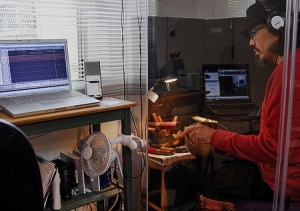 One of the ways we seek to preserve this legacy is to develop and maintain strict standards on the quality of the recordings we produce, recording both the struck and rim tones of each singing bowl and Master Healing Set that we sell on our site. In our Large Singing Bowl Galleries, we also record the fundamental (deeper) tones as well. These recordings have improved as technology and bandwidth have evolved, but improvement is a never ending quest. We try to give our customers the most faithful experience of the bowls possible. Our recording artist Son Vo (pictured left) has a wonderful hand on the bowls and scrubs the recordings clean of rim noise, sirens, aircraft, traffic, dogs, crows, and other sounds of West Los Angeles daily life.
One of the ways we seek to preserve this legacy is to develop and maintain strict standards on the quality of the recordings we produce, recording both the struck and rim tones of each singing bowl and Master Healing Set that we sell on our site. In our Large Singing Bowl Galleries, we also record the fundamental (deeper) tones as well. These recordings have improved as technology and bandwidth have evolved, but improvement is a never ending quest. We try to give our customers the most faithful experience of the bowls possible. Our recording artist Son Vo (pictured left) has a wonderful hand on the bowls and scrubs the recordings clean of rim noise, sirens, aircraft, traffic, dogs, crows, and other sounds of West Los Angeles daily life.
But the real impetus for this project is more personal – a desire for the bowls to be heard as broadly as possible, and for their sound to endure beyond their lifetimes. So we’re creating an archive of this treasure trove of sound files, which will require a great deal of time to organize (we’re always looking for intern help with this project!). I’m driven by the awareness of how relatively rare it is that this cross current of antique singing bowls should all flow through this time and place; and a sense of responsibility to document them all. Especially the sets, as to our knowledge, there have never been recordings of singing bowl sets before. And as we craft these handmade, very individual pieces together to form intervals and scales, I’m struck with the reality that these sets will not stay together forever. So we seek to preserve the relationships of these bowls. And the basic fabric of our recording will be woven with these sounds.
 The Bodhisattva recording will also feature live sessions as well. For the past two years, Son and I have been recording sessions with the bowls in the studios of Lotus Post, in Santa Monica, California. We did our first session with the inspiration to interweave one of our best diatonic sets together with one of our best pentatonic sets, utilizing not just striking tones, but all of the fundamental and rim tones as well. Lotus Post’s founder, Michael Perricone, a bowl master himself, has been a driving force in helping us with the project as producer, engineer and at the onset of the project, a co-musician as well.
The Bodhisattva recording will also feature live sessions as well. For the past two years, Son and I have been recording sessions with the bowls in the studios of Lotus Post, in Santa Monica, California. We did our first session with the inspiration to interweave one of our best diatonic sets together with one of our best pentatonic sets, utilizing not just striking tones, but all of the fundamental and rim tones as well. Lotus Post’s founder, Michael Perricone, a bowl master himself, has been a driving force in helping us with the project as producer, engineer and at the onset of the project, a co-musician as well.
In our last antique collection, we received a flurry of concert-pitch Highwalls, four tuned to concert pitch on the fundamentals (C, A & two matching Fs) and two tuned concert pitch on the rims (E & G). It was an anomaly that so many Highwalls tuned to whole tones should all come together in the same collection. I have only completed one antique Highwall set and it took about four or five years to complete. That set was matched on the rims, from a fifth octave C to a B (featured in our Crown Chakra Meditation video). However, we had no recording of anything with whole tones mixed between the rims and fundamentals. So, on a beautiful, late summer evening, we took the bowls to Lotus Post to capture their resonance together, before they parted ways forever.
What I loved about this collection is that they all had something to say to each other, and I felt as though I was sitting in on a conversation conducted in a universal tongue. Despite their varying densities, their timbres were well matched and I loved the interplay of the whole tones referencing each other across the octaves, with their flatted fifth harmonies dancing in between. I felt so blessed to have been in the room when they all came together.
Son and I have a rough layout of the sequencing, but our “day jobs” come first! So the project is slowly getting done as soon as the flow of work allows. Please stay tuned!
Initiated in 1999 by Jem Finer, this project is a composition of Tibetan singing bowls designed to play until 2999. Click on the link below to listen.
![]()
![]()
![]()
 Longplayer’s first live performance, The Roundhouse, 2009. [Atherton-Chiellino] [ENLARGE]
Longplayer’s first live performance, The Roundhouse, 2009. [Atherton-Chiellino] [ENLARGE]
What is Longplayer?
Longplayer is a one thousand year long musical composition. It began playing at midnight on the 31st of December 1999, and will continue to play without repetition until the last moment of 2999, at which point it will complete its cycle and begin again. Conceived and composed by Jem Finer, it was originally produced as an Artangel commission, and is now in the care of the Longplayer Trust.
Longplayer can be heard in the lighthouse at Trinity Buoy Wharf, London, where it has been playing since it began. It can also be heard at several other listening posts around the world, and globally via a live stream on the Internet. Longplayer started playing at three separate listening posts in London and Sydney at 00:00 hours (IDLE) on the 1st of January 2000 (i.e. midnight on the International Date Line – midday on the 31st of December 1999 in London).
Longplayer is composed for singing bowls – an ancient type of standing bell – which can be played by both humans and machines, and whose resonances can be very accurately reproduced in recorded form. It is designed to be adaptable to unforeseeable changes in its technological and social environments, and to endure in the long-term as a self-sustaining institution.

The listening post at the Lighthouse, Trinity Buoy Wharf, 2000. [Steve Pyke]
The Long Term
Longplayer grew out of a conceptual concern with problems of representing and understanding the fluidity and expansiveness of time. While it found form as a musical composition, it can also be understood as a living, 1000-year-long process – an artificial life form programmed to seek its own survival strategies. More than a piece of music, Longplayer is a social organism, depending on people – and the communication between people – for its continuation, and existing as a community of listeners across centuries.
An important stage in the development of the project was the establishment of the Longplayer Trust, a lineage of present and future custodians invested with the responsibility to research and implement strategies for Longplayer’s survival, to ask questions as to how it might keep playing, and to seek solutions for an unknown future.
Composition in Time
Longplayer is composed in such a way that the character of its music changes from day to day and – though it is beyond the reach of any one person’s experience – from century to century. It works in a way somewhat akin to a system of planets, which are aligned only once every thousand years, and whose orbits meanwhile move in and out of phase with each other in constantly shifting configurations. In a similar way, Longplayer is predetermined from beginning to end – its movements are calculable, but are occurring on a scale so vast as to be all but unknowable.
Longplayer’s composition uses a minimum amount of information and material to create the maximum amount of variety, in terms of both sound and form. While it is a system-based composition, it is made out of very expansive and resonant musical material, which in itself is not ‘systematic’ sounding. This material (the ‘source music’) is played on Tibetan singing bowls, which possess a simple but harmonically rich sound, and a quality which is at once both physical and ethereal. A simple form of synthesis arises from the interactions of these instruments’ waveforms, with the consequence that while Longplayer’s score is deterministic, its music at any given time is unpredictable.
Technology
At present, Longplayer is being performed mostly by computers. However, it was created with a full awareness of the inevitable obsolescence of this technology, and is not in itself bound to the computer or any other technological form.
Although the computer is a cheap and accurate device on which Longplayer can play, it is important – in order to legislate for its survival – that a medium outside the digital realm be found. To this end, one objective from the earliest stages of its development has been to research alternative methods of performance, including mechanical, non-electrical and human-operated versions.
Among these is a graphical score for six players and 234 singing bowls. The first performance based on this score took place over 1,000 minutes on 12 – 13 September, 2009, at the Roundhouse, London. Longplayer Live is performed on a vast, specially-constructed instrument by an orchestra of players working in shifts. A series of further performances are in planning for various venues around the world – see the Live page for more information.
The first Longplayer leaflet, 1999. [Artangel]
Who Created Longplayer?
Longplayer was developed and composed by Jem Finer between October 1995 and December 1999, with the support and collaboration of Artangel. It was managed by Candida Blaker, with a think tank comprising artist Brian Eno, British Council Director of Music John Keiffer, landscape architect Georgina Livingston, Artangel co-director Michael Morris, digital sound artist Joel Ryan, architect and writer Paul Shepheard and writer and composer David Toop. A full account of Longplayer’s development can be found in the 2003 book Longplayer, published by Artangel, London.
Jem Finer is a UK-based artist, musician and composer. Since studying computer science in the 1970s, he has worked in a variety of fields, including photography, film, music and installation. Longplayer represents a convergence of many of his concerns, particularly those relating to systems, long-durational processes and extremes of scale in both time and space. Among his other works is Score For a Hole In the Ground (2005), a permanent musical installation in a forest in Kent. Self-sustaining and relying only on gravity and the elements to be audible, the project continues Finer’s interest in long-term sustainability and the reconfiguring of older technologies.
Based in London and working both in the UK and internationally, Artangel has been commissioning and producing ambitious projects by contemporary artists for the last two decades. Often surprising in both conception and scale, each project begins with an invitation to an artist to develop a new work, inspired and given shape by a particular place. Artangel works closely with the artist to realise the full potential of the work in whatever form, medium and context seems best. Since the early 1990s, Artangel has produced over fifty major new commissions including Rachel Whiteread’s House (1992), Michael Landy’s Breakdown (2001), Francis Alys’ Seven Walks (2005) and Heiner Goebbel’s Stifters Dinge (2008). Artangel is supported by the Arts Council of England and The Company of Angels. Visit www.artangel.org.uk for more information.

All content © 2012 The Longplayer Trust. Contact: info@longplayer.org . Designed and built by Moneymouth.
William Ward, a former New Yorker who resides now in Pensacola, FL was a Chef for 13 years. To relieve his job related stress, he discovered meditation. He now has a full time sound healing practice and has been a Bodhisattva customer since 2009. William will be playing his collection of Bodhisattva singing bowls on the program shifthappensradio.com on 6/21/12. We are in the process of building William a two-octave Master Healing set.
How did you get involved with bowls?
That’s one of the most important questions. It started with a meditation. In a meditation, there was a sound that I can’t even begin to describe with words – it brought a knowing of an unconditional love that was there – just the deepest experience of peace I’d ever had. What it taught me was that God was real within us, which was what I was looking for and was the reason I was meditating. A few months later, I walked into a conscious living store, heard a CD playing and heard the bowls. Tears of remembrance of the sound I experienced flooded me, and I knew I had to look into it. And that’s how it all started.
You started with Crystal bowls?
The Crystal bowls and Tibetan bowls came at the same time.
What were you looking for?
I was looking for what I had experienced in that sound and I wasn’t finding it everywhere. That’s why I stuck with you guys. I’ve done a lot of research and looked around and you guys connected very well with everything I was looking for.
Did you study with any one?
I read some books, Mitchell Gaynor, “The Healing Power of Sound”, and Jonathan Goldman “Healing Sounds”. They were both very helpful, as they expressed my experience in ways I couldn’t yet grasp with my own words. Reading up on it helped me to find my own words, for which I am eternally grateful.
So you never studied with anybody, but you read the books and got started from there?
Yes. It was more an intuition that just brought everything together – the more I worked with them and shared them, the more intuition expanded from the experience. The experience was the knowing. I just followed that.
Please talk to me about how you integrate the Crystal and the Tibetan Bowls. Usually people resonate with one or the other.
What I was looking for was to recreate that sound in the experience I had – it is my wish for everyone to experience that for themselves. I found that to re-create that sound, I had to use more bowls, I had to fill in certain spaces. And it opened my eyes to see how chords were playing while I was filling in the spaces, and it expanded from there. I loved the harmonies and the timbres and the higher frequencies when I brought in the Tibetans.
Tell me how you work with the Chakras.
I was very skeptical about the Chakras and didn’t understand them in the beginning. So I really put some time into understanding them for myself. It’s psychosomatic, because our Chakras lie along our Central Nervous System. I realized what effects our nervous system the most is our thoughts about reality. Who I think I am affects every way in which I will express myself.
We’re all spirit having a human experience; however, if I’m too connected to the human experience it limits that awareness. Where our blocks happen is when we forget this reality. Reality is itself the seen and the unseen working hand in hand. I started seeing everything as vibration – whether you can see it or not, it is in vibrating form like an orchestra playing its song. So when I say reality, everything in existence has its song that it’s singing, each component or instrument is vital for the whole composition. And we as humans have that awareness of observation. So where and who we think we are, we are. But we don’t have to stay there. And that’s the correlation I was making with the Chakras being psychosomatic – reality is limitless, it always has been.
Usually when we hear the word psychosomatic, it refers to someone manifesting a physical condition simply by believing they have it. Is that what you mean be psychosomatic?
Not manifesting, but knowing it to be true. For example, our Root Chakra is connected with physicality. And we can stop there, which most of us do, or we can look to see energetic origins of physicality, which would raise our awareness of that Chakra more.
How did you choose working with the diatonic scale system as the basis of the Chakras as opposed to any other system?
I never put any thought to it, I just went where I was guided, which isn’t as simple as it sounds. I just went with my intuition. But I do love to learn how other people use their styles and techniques.
When you do your sessions, you just put the Tibetans on the body?
Almost always. Sometimes I’ll also place the crystal bowls on the body.
How do you decide that?
Each session is different. There’s a knowing in the moment. What I love about the bowls is that it’s not imparting a verbal knowledge to them, it’s sharing the experience with them, which is priceless.
Why do you do what you do?
It was important for me when I experienced that peace within, that became my new passion. And I know that when everyone can find that place that is within them, we will all know, so naturally, how we can move forward together, in a sustainable way for the environment, our children and their children.
Tell me about the show you’re doing.
El – the host of Shift Happens radio – called me and said that she’d heard from quite a few people about me, and she wanted me to come on for a two hour segment. It will be airing 10 PM EST 6/21 and will be available on podcast afterward. www.shifthappensradio.com.
Tell me about the collection from BTC you will be using tomorrow.
I’ll definitely be using my C# Highwall and the Pentatonic set, and then I’ll use Pentatonic cup set if I have the spacing. I have one E that was gifted to me that’s a 10 or a 12”, so I don’t know if I’ll have the space for it or not. For the crystal bowls, I have an Alchemy set.
So you will be giving us that experience tomorrow. We’re really looking forward to hearing it!
 Marie Bergman, a musician and singer from Stockholm, Sweden, visited Bodhisattva on a quest to find a bowl. With great ease, she selected a 10 7/8″ with a slightly sharp G fundamental on the second octave – a perfect choice for a singer. As she bonded with her bowl, she began to sing – almost as if her process of getting to know the bowl was to sing with it. Ever ready with my trusty iphone, I captured the moment in video. Marie was also kind enough to give her an interview and talk about her work:
Marie Bergman, a musician and singer from Stockholm, Sweden, visited Bodhisattva on a quest to find a bowl. With great ease, she selected a 10 7/8″ with a slightly sharp G fundamental on the second octave – a perfect choice for a singer. As she bonded with her bowl, she began to sing – almost as if her process of getting to know the bowl was to sing with it. Ever ready with my trusty iphone, I captured the moment in video. Marie was also kind enough to give her an interview and talk about her work:
Can you tell us about your background in music?
I am a professional musician and singer/songwriter for some thirty years. I have made twenty recordings with my own compositions and three CDs with jazz music. I have been touring in Scandinavia for many years and have also represented Sweden in a European Song contest three times. My voice has a pretty wide range and I have always all the time been searching for more ways of expressing myself through the wonders of the voice. I find the voice has endless possibilities!
Your singing felt like a lullaby to me. Were you at all influenced by the folk music of Sweden?
Well, folk music is running in my blood but it is not the core of my expression. When I sing with the bowls it often shines through like an archetypal depth of the voice. But my toning comes out differently each time.
How did you come to explore harmonics?
In the mid-80’s I had a lot of problems with my voice. I was performing rock n roll and raw soul, and I was hard on the voice. I was also in pain from too much tension. This all together created a (very much needed…) breakdown. I silenced myself for a long time and when I returned to the sound again, I learned to sing and express myself differently. I also during this time experienced the healing power of the voice and learned to breathe much deeper. I started to meditate and take care of myself. I became fascinated of the voice´s capability to adjust and how it helped me mature my singing and through this I started to experience toning as a training method. It became my freedom. And that helped me keep the singing voice even more fresh and vital. I discovered there was a lot of power and life force in the harmonics. I started to listen to them very carefully.
How do you use harmonics in your music?
I differ my singing voice from the toning voice. My singing voice is a storyteller, where the words are important but also the sounds of the words. Songs are form. Harmonics makes my singing voice more clear and lifts the flow, making the singing physical and powerful without pressure. When I tone, I stay more purposely with the harmonics, letting them vibrate and resonate in their own frequency and time. Together with the bowls, the expression gets strong and spiritual. I use the mouth and the body resonators differently when I tone. I become like a wind instrument.
What attracted you to singing bowls?
The beautiful archetypal sound, the physical resonance, the timeless vibration, the beauty and the wisdom!
How do you use their vibration in sound healing?
I work with voice and Ssinging bowls in different settings. Sometimes more performance-like when the purpose is to gather people. When I do sound healing on the bodymind, I direct the sounds from the bowl and my voice to the body (my own or another’s) with a special intention. I also put the different bowls on different parts of the body of a client when I do ”singing bowl-massage”. I am trained in sound healing as well as in the ”Peter Hess method” of singing bowl-massage. I often combine sound healing and singing bowl-massage and train others as well. Peter Hess singing bowl-massage is a wonderful, deep relaxation method for regaining spiritual and physical health, to refresh and vitalize your cells as well as your muscles, tissues and organs. In the massage, I place different sizes of bowls on different specific parts of the body. I strike them gently and let the beautiful matching frequencies of the bowls do their magic wave work with elegance and grace.
Tell us of how you are using the bowls in your community.
My own voice school BERGMAN VOICE and the use of singing bowls has developed as an extension from my singing seminars and teaching at the Music Conservatories in Sweden, Norway and Denmark. I run seminars in toning and voice workshops all year round. I offer singing bowl-massage. Sometimes I perform with the bowls and let them illustrate a poem or resonate beautifully and sensually with a song. I always have them with me even when I give singer/songwriter performances solo or with the band. I use them in the concerts in at least one or two songs.
I use the bowls when I do my gatherings in one of the biggest churches in Stockholm, the Katarina church. I call it ”Come Together-Ceremonies”. Everyone is welcome. I always open this ceremony with the singing bowl and my voice, an improvisation where the resonance is flying freely under the heights in the cathedral. It always gives me and everybody goose bumps. Then I teach the audience how to tone and they gather in a circle with their voices and I also let them walk around in the church, singing freely. They are happy! It’s very beautiful. See the You Tube link.
How did you discover the language?
I was training a lot with the voice, also did a quite heavy sound therapy and sound healing to clean blockages and resistances in the beginning to allow myself to get out of the box. When I started to play the bowls it kind of powered up the voice by itself. I guess the voice was very happy about the good vibrations! I learned to keep out of pressure as much as possible and another language was discovered and created.
Do you find yourself at home in a certain key?
I try to widen the voice range as much as possible. I find that all the frequencies has its own fascination. I also find that harmonics has helped my voice to expand and move freely among the different keys as much as possible. Voice is the mirror of the life force!
Do you believe specific notes are associated with the Chakras?
Yes. But I found they differ a bit from person to person. But of course they range from low to higher and the other way around.
How can one purchase your recordings?
Spotify on my name: Marie Bergman. But I haven’t yet recorded my toning with the singing bowls. Maybe sooner than later hopefully…
We hope sooner, Marie!
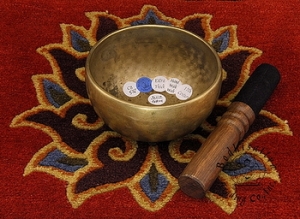 As part of our Guest Series, I’m delighted to share my conversation with Rona C, a psychiatrist from Feasterville, PA and a recent customer of Bodhisattva. She was kind enough to discuss how she uses a Tibetan singing bowl in her work.
As part of our Guest Series, I’m delighted to share my conversation with Rona C, a psychiatrist from Feasterville, PA and a recent customer of Bodhisattva. She was kind enough to discuss how she uses a Tibetan singing bowl in her work.
Tell us about your practice.
I am an outpatient psychiatrist in private practice in Feasterville, PA. I graduated from Duke Medical School in North Carolina and did my residency at Hahnemann University in Philadelphia PA. I am board certified in psychiatry with added certification in geriatric psychiatry. I have been in private practice for 24 years and see many patients suffering with anxiety and depression.
Do you think there has been an increase in the amount of cases you’re seeing for these disorders?
There seems to be an increase in the number of people suffering from these disorders. I believe this is partly due to the increasing stress and distortion in our world. Technology, which is so rapidly evolving, and while offering so many benefits has contributed greatly to this stress. Our daily lives and the expectations placed on us are straining our biology which has taken millenia to evolve. Our bodies evolved in synchrony with the rhythms of nature, the yearly, seasonal, and circadian to name a few. Technology has made honoring these rhythms more irrelevant to our lives. This puts a strain on our bodies, minds and spirits and diseases such as depression and anxiety are triggered.
Humans evolved as social animals who are influenced by and benefit from human contact on a physical and chemical (ie pheromone) level. For instance, it is well documented that women living in close quarters become synchronized in their menstrual cycles. We are deprived of this with the increase of long distance and virtual interactions. It has been stated that thoughts and emotions have electromagnetic properties which can not be communicated as completely with this type of interaction. This attenuation in the intensity of the biological and electromagnetic communication contribute to a loss of grounding, a disconnection, a sense of isolation all which contribute to the rise of depression and anxiety.
It has been stated that abnormal reactions are normal in abnormal circumstances so perhaps this epidemic of anxiety and depression is in fact a normal result of the present world.
How are you using the bowl in your practice?
The bowls have a calming soothing effect on my patients. Their beautiful song seems to resonate with and calm the nervous system in a sweet, non intrusive and nonthreatening way. This morning I saw a woman with dental pain radiating to her face and neck. When I played the bowl for her, she said that it seemed to quiet the nerves. People who are so anxious that even relaxation techniques escalate their stress can experience relief with the bowl.
Do you think this is a result of brainwave entrainment, or are there other factors?
Modern physics is teaches us that all matter in our bodies is composed of vibrating waves. I believe that the singing bowl helps to entrain the vibrations into a cohesive concordant as opposed to discordant pattern. I believe the brainwaves are also entrained and this then further enhances the entrainment of the rest of the body.
How do you use the bowl in a session?
I am still learning about the many ways to use the bowl in a therapeutic manner. I will never use it without first asking the patient’s permission. I’ll tell a patient “I’d like to play this bowl for you, I think it’s going to be very calming. So sit back, try to relax, close your eyes and let it envelop you.” I instruct them to tell me if they need me to stop playing the bowl at any point. That has not happened yet though. I also play the bowl between sessions to refuel and relax.
And what reactions are you getting?
People generally become more relaxed, sometimes they tap in to deep emotions. I played it for someone who was telling me about her 16 year old dog who was dying. I played while she was talking, it seemed to help her connect more powerfully with the deep wells of emotion in her heart.
Do you feel that there is a potential for a lasting effect?
I do. The two minutes that I am able to play for my patients in my current practice format produces a temporary reprieve. It’s like changing the channel from stress to contentment. But I feel a paradigm in which I have a set of healing bowls which could be played for a prolonged period could cause lasting healing.
Do you sense a potential for vibrational therapy to be used as an adjunct therapy in a clinical setting? Would you consider prescribing a patient vibrational therapy as opposed to medication in certain circumstances?
I do feel there is great potential for adjunct use of vibrational therapy in a clinical setting and I hope to incorporate this into my own practice. For certain patients such as those who cannot tolerate, have had a poor response to or prefer a holistic approach to that of a pharmaceutical approach, vibrational therapy is an intriguing alternative.
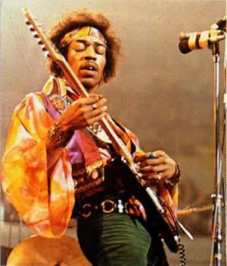 If you lived through the 60’s, the term “Wah-Wah” conjures memories of Jimi Hendrix’s Voodoo Child, or the theme from the 70’s movie Shaft, but probably not an image of a Tibetan Singing Bowl. While all singing bowls naturally produce oscillating frequencies, the Hand Wah-Wah is added oscillation capability in certain, specially constructed singing bowls which can be manipulated to modulate its sound waves by gently squeezing the base of the bowl with the holding hand.
If you lived through the 60’s, the term “Wah-Wah” conjures memories of Jimi Hendrix’s Voodoo Child, or the theme from the 70’s movie Shaft, but probably not an image of a Tibetan Singing Bowl. While all singing bowls naturally produce oscillating frequencies, the Hand Wah-Wah is added oscillation capability in certain, specially constructed singing bowls which can be manipulated to modulate its sound waves by gently squeezing the base of the bowl with the holding hand.
The first bowl that actually “spoke” to me – that clearly communicated (as if it were speaking English) that it was my bowl – was a Hand Wah-Wah bowl. It was awkward. Our bed & breakfast suite was open for a trunk show in Sedona, Arizona, and a couple of ladies were hovering over a kitchen table crammed with bowls. I struck one bowl randomly (ha!) out of the crowd, and immediately heard the “bend” in the struck tone. I’d never heard anything like that and I wanted to hear more! But I didn’t want to draw my customer’s attention to it, cause I was afraid they’d notice how cool it was. So I waited til they picked up another bowl and when they were completely focused on it, I snatched my bowl and stowed it under the table! It was love at first sound: that bowl sat by my altar for the next 11 years. I spent hours losing myself in its kaleidoscopic harmonies.
How is the Hand Wah-Wah different from the other modulations that singing bowls make? When heard binaurally, singing bowls naturally produce beat frequencies that sound like an oscillation of the bowls’ harmonics. All singing bowls produce these beats: they are the bowl’s pulse which kinetically entrains our brainwaves and calm the mind for meditation. They’ve worked this way for thousands of years. Often, two separate pulses can be perceived: usually a slower pulse in the fundamental tone and a faster one in the female overtone. But this is not the “wah-wah” effect; these oscillations are just “standard equipment” in a singing bowl.
Hand Wah-Wah bowls are different. In 16 years I’ve been working with singing bowls, I honestly have no idea what is different about their physical structure that enables us to produce these modulations. I’ve studied the bases of these bowls. They are both thick and thin; their bases are rounded as well as flat; I have found no physical common denominator between them. All I know is that Hand Wah-Wah bowls are rare; usually only a handful of bowls in any collection will have that capability. They look like ordinary, Thadobati style, antique singing bowls.
So to get the effect, you first need to know your bowl has a Hand Wah-Wah capability. We will usually notate this capability in our description of our singing bowls; they turn up most often on the Medium bowl section in our Singing Bowl Galleries. Wherever you find it, once you know you have one, here’s how you get the technique:
1) Start by looking at the position of the bowl on your holding hand. It should be positioned so that just your fingertips are slightly extended beyond the base of the bowl. In most instances, you want to avoid wrapping your fingertips around the curve in the bowl’s base, as that can dampen a bowl’s sound. However, with this technique, slightly wrapping your fingertips around the bowl’s base can sometimes enhance the Wah-Wah effect.
2) Strike your bowl with the covered end of your mallet. Whether it’s covered with leather or wool doesn’t really doesn’t matter, but bear in mind that the suede mallet will emphasize the mid and female overtones in a bowl, and those are the tones that lend themselves to the Hand Wah-wah effect the best.
3) Once struck, very gently squeeze the base of the bowl with your holding hand. It’s important to note that you are contracting your hand with every squeeze and as you do, a space opens up between your hand and the base of the bowl. This is where the sound is being modulated. On some bowls, the hand wah-wah is positional: they will have a “sweet spot” where it jumps out at you. So if you don’t find the wah-wah at first, rotate the bowl around until you find it. Another technique that works is to rock the bowl from your fingertips to the heel of your hand.
You can also see videos on You Tube of people making a “wah-wah” sound by modulating the bowl’s sound waves with the aperture of their mouths. Except for certain really dense and thick singing bowls, almost any singing bowl will respond to this technique. Strike your bowl and place your mouth about an inch away from the upper wall near the rim. Then, purse your lips in a fish-like motion. You don’t have to vocalize at all, just play with shaping the sound waves in your mouth by the dilating aperture of your lips. This too is positional: if you don’t hear anything at first, rotate the bowl around until you find its “sweet spot”. The richer the harmonics of the bowl, the more bend you can get out of the wah-wah. The larger and more sloped the bowl’s wall, the tones there you can isolate and bend. What’s great is to actually “taste” the tingly sensation of the sound waves in your mouth – delicious!
To see a quick video demo on both techniques, please check the video page on our Website. Have fun!
Last Summer, I posted a video on Facebook aired by the BBC entitled “On How Tibetan Singing Bowls Are Making Waves in Physics”. The following guest blog includes ensuing comments by Dr. Jeffrey Thompson, D.C., B.F.A C.N.S.T./ Diplomate. Dr. Thompson is a foremost leader in scientific research using sound therapy for altering brainwave states for mental, physical and emotional healing. Steve Sklar, a musician and sound healer joined in as the thread of conversation meandered from physics of singing bowls’ waveforms to their metallurgy. A debate ensued on the subject of the Oxford metallurgical analysis of singing bowls commissioned by Himalayan Bowls that reported the bowls were made of an alloy almost exclusively of copper and tin. I quoted an earlier analysis done by Concordia University in Quebec that may have resulted in the famous “7 Metals” alloy, which included gold and Mercury. Sorry, folks, I’m just getting around to posting the paper now. Enjoy!
Say something about this…

-
Aedan Kelly and Steve Sklar like this.
-
-
 Jeffrey ThompsonNice one…..scientists eventually get around to discovering what the sages have known for millennia…July 2 at 12:52pm · Unlike · 2 people
Jeffrey ThompsonNice one…..scientists eventually get around to discovering what the sages have known for millennia…July 2 at 12:52pm · Unlike · 2 people -
 I demonstrate these effects in my Sound Healing workshops (without the slo-mo video, of course). But I usually prefer to use larger bowls for a better effect/view. You can vary the amount of water to get either wave patterns and/or fountain effects.July 2 at 12:52pm · Unlike · 1 person
I demonstrate these effects in my Sound Healing workshops (without the slo-mo video, of course). But I usually prefer to use larger bowls for a better effect/view. You can vary the amount of water to get either wave patterns and/or fountain effects.July 2 at 12:52pm · Unlike · 1 person -
I also do this same demonstration with water in the bowls….the big crystal bowls work bets as a demo because of their large diameter. Another cool demo is to lay a nice big speaker on its back and fill the cone of the speaker with water and play sounds and music through it.July 2 at 2:15pm · Unlike · 1 person
-
 correct…its a good demo of sound becoming visible because of the clear resonant patterns in the water, each metal bowl shows a much more complex wave form since Tibetan Bowls have multiple frequencies…monophonic binaural beats.July 2 at 3:38pm · Unlike · 1 person
correct…its a good demo of sound becoming visible because of the clear resonant patterns in the water, each metal bowl shows a much more complex wave form since Tibetan Bowls have multiple frequencies…monophonic binaural beats.July 2 at 3:38pm · Unlike · 1 person -
 Jeffrey ThompsonIve done extensive spectral analysis studies of Tibetan Bowls, you can clearly see from two to 4 peak frequencies per bowl…all within the critical bandwidth of one another. Definitely creating a brain entrainment pulse pattern per bowl. Since the interactions of different diameters of the bowl’s shape equal binaural beats, but these beats are not from two separate sources, but contained within the structure of a single bowl, I have named this “Monophonic Binaural Beats”. By the way, whenever I think I’ve discovered some new, cool, 21 century, futuristic application of sound for healing or changing consciousness, I usually find that the Tibetans did it first a few thousand years ago……July 2 at 3:45pm · Like · 1 person
Jeffrey ThompsonIve done extensive spectral analysis studies of Tibetan Bowls, you can clearly see from two to 4 peak frequencies per bowl…all within the critical bandwidth of one another. Definitely creating a brain entrainment pulse pattern per bowl. Since the interactions of different diameters of the bowl’s shape equal binaural beats, but these beats are not from two separate sources, but contained within the structure of a single bowl, I have named this “Monophonic Binaural Beats”. By the way, whenever I think I’ve discovered some new, cool, 21 century, futuristic application of sound for healing or changing consciousness, I usually find that the Tibetans did it first a few thousand years ago……July 2 at 3:45pm · Like · 1 person -
 Steve SklarRe: the binaural aspect, seems more accurately stereo to me, especially when the bowls are placed in front of one’s face; very different than when played lower down, on a table, floor, etc.Esp. interesting to me are the recent metallurgical analyses of singing bowls…July 2 at 4:11pm · Like · 1 person
Steve SklarRe: the binaural aspect, seems more accurately stereo to me, especially when the bowls are placed in front of one’s face; very different than when played lower down, on a table, floor, etc.Esp. interesting to me are the recent metallurgical analyses of singing bowls…July 2 at 4:11pm · Like · 1 person -
 Jeffrey ThompsonBetween 1970-1977 I owned a company that involved alloying and smelting metals, mold making and casting. I was heavily involved in the mixing of custom alloys of bronze, brass, and pewter. It has been pretty obvious to me that most Tibetan Bowls are a custom alloy of “Bell Bronze” which is a certain mix of mostly Copper and lesser % of Tin. Brass, btw, is Copper and Zinc. It would be a very difficult proposition for early metalsmiths to include high melting point metals like nickle and especially a very high melt point metal like iron. Most Bowls are an alloy of Copper and tin. I think it is a myth that some ancient bowls were made of meteorite material, since most meteorites are iron and some iron / nickel.Jeffrey Thompson (Quoting Himalayan Bowls’ article)
Jeffrey ThompsonBetween 1970-1977 I owned a company that involved alloying and smelting metals, mold making and casting. I was heavily involved in the mixing of custom alloys of bronze, brass, and pewter. It has been pretty obvious to me that most Tibetan Bowls are a custom alloy of “Bell Bronze” which is a certain mix of mostly Copper and lesser % of Tin. Brass, btw, is Copper and Zinc. It would be a very difficult proposition for early metalsmiths to include high melting point metals like nickle and especially a very high melt point metal like iron. Most Bowls are an alloy of Copper and tin. I think it is a myth that some ancient bowls were made of meteorite material, since most meteorites are iron and some iron / nickel.Jeffrey Thompson (Quoting Himalayan Bowls’ article) -
“Scientists at the University of Oxford studied a group of antique singing bowls from Himalayan Bowls during 2010. Archaeological Metallurgists from the renowned university’s Department of Materials have confirmed Himalayan Bowls’ own metallurgical analysis and dating assessment of antique singing bowls. Dr. Peter Northrup and his team examined a group of antique bronze bowls from 16th – 19th century, including one bowl that could be much older…
-
“Singing bowls are made from a high-tin bronze alloy. This special alloy is made from 77-78% copper, 22-23% tin. This type of metal is known as “bell metal bronze” and is found in most of the world’s best bells, gongs and cymbals. The high tin content is partly responsible for the beautiful tone produced by singing bowls. Very little variation in the alloy has been found in more than 100 singing bowls tested by Himalayan Bowls…“According to the scientists at Oxford, the high tin content makes the bowls less likely to crack during manufacturing. They were impressed by the craftsmanship. Himalayan Bowls’ research found a few singing bowls containing less than 2% iron. Other than these exceptions, all antique singing bowls tested contain only copper and tin…
-
“The pure bronze alloy used in singing bowls shows real mastery and knowledge of the material. The hand hammering annealing technique used to make singing bowls goes back 4,000 years. Singing bowls are a last remnant of an ancient metal working tradition. Bronze bowls have been made in the Himalayas for centuries – perhaps for 1,000 years. The new handmade singing bowls offered by Himalayan Bowls are made of the same high quality bronze as the fine antiques…
-
“It is remarkable to think that our singing bowls are part of one of the world’s oldest crafts and that the materials and techniques have remained unchanged for thousands of years.”
-
 Naga ShaktiWow I actually was off Facebook all day and I come back to find this. Thanks for the cool thread, Jeffrey. Actually the British Museum posted a different alloy composition of Tibetan bell metal that was much more varied – I’ll try to scan it & post it. Joseph told me about the analysis he did. I find it hard to believe that there was so little variance in the alloy content, considering that the bowls were made over such a broad geographic span and over such a long period of time. It makes sense to me that the ancient metal smiths utilized the raw materials available to them; and it makes sense to me also that the metal smiths varied their alloys according to the density of the metal bowl they wanted to produce, which would affect the harmonics produced.July 2 at 9:32pm · Like · 1 person
Naga ShaktiWow I actually was off Facebook all day and I come back to find this. Thanks for the cool thread, Jeffrey. Actually the British Museum posted a different alloy composition of Tibetan bell metal that was much more varied – I’ll try to scan it & post it. Joseph told me about the analysis he did. I find it hard to believe that there was so little variance in the alloy content, considering that the bowls were made over such a broad geographic span and over such a long period of time. It makes sense to me that the ancient metal smiths utilized the raw materials available to them; and it makes sense to me also that the metal smiths varied their alloys according to the density of the metal bowl they wanted to produce, which would affect the harmonics produced.July 2 at 9:32pm · Like · 1 person -
 Jeffrey ThompsonI think part of the reason that the bowls alloy has been so generally consistent over time is the availability of copper and tin (and zinc for brass) and also because they all have a similar melting point that can be achieved without extraordinary measures for blast furnaces, etc. The monophonic binaural beats in the bowls is a function of the bulging shape of each bowl and is unique and the harmonics are partially a property of this and a property of the alloy itself. Minor shifts of % of copper to tin can make a very large difference in quality of tone, harmonics and brilliance. Also the sophistication of the purity of the molten metal and skimming of dross techniques applied. There is a real art to alloy making, mold making and casting of metals. I always felt like an alchemist when I was doing it myself….July 2 at 11:04pm · Unlike · 1 personHere it is, Jeff. Sorry for the delay…Regarding The British Museum Study we have referenced by W.Z. Oddy and W. Zalf (Occasional Paper no. 15, 1981), that will be the subject of another edition. Anyone with any other info on any other analyses published, I’d be happy to include them in future editions.
Jeffrey ThompsonI think part of the reason that the bowls alloy has been so generally consistent over time is the availability of copper and tin (and zinc for brass) and also because they all have a similar melting point that can be achieved without extraordinary measures for blast furnaces, etc. The monophonic binaural beats in the bowls is a function of the bulging shape of each bowl and is unique and the harmonics are partially a property of this and a property of the alloy itself. Minor shifts of % of copper to tin can make a very large difference in quality of tone, harmonics and brilliance. Also the sophistication of the purity of the molten metal and skimming of dross techniques applied. There is a real art to alloy making, mold making and casting of metals. I always felt like an alchemist when I was doing it myself….July 2 at 11:04pm · Unlike · 1 personHere it is, Jeff. Sorry for the delay…Regarding The British Museum Study we have referenced by W.Z. Oddy and W. Zalf (Occasional Paper no. 15, 1981), that will be the subject of another edition. Anyone with any other info on any other analyses published, I’d be happy to include them in future editions. -
For those of you who interested in knowing what Dr. Thompson means monophonic binaural beats, that blog will be in the works as well.
-

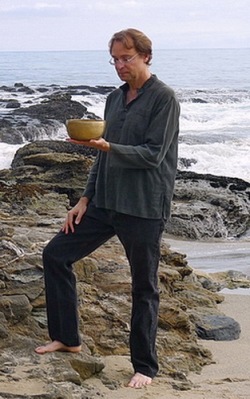
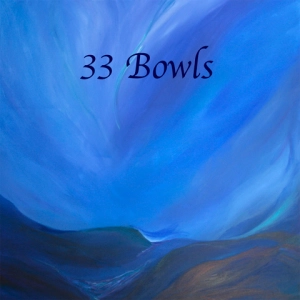
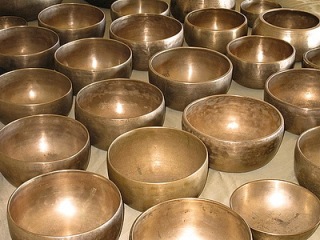



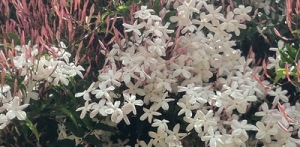
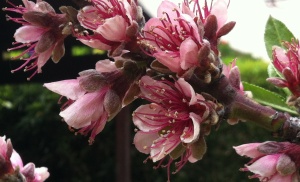
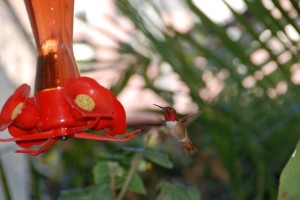
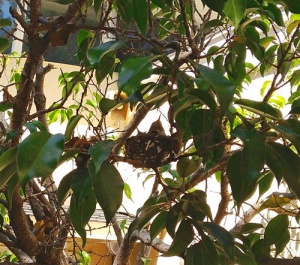
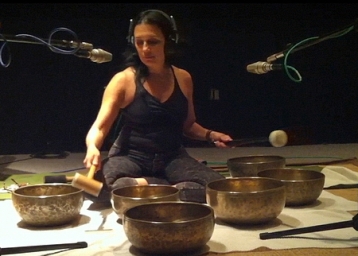
![The first Longplayer leaflet, 1999. [Artangel] The first Longplayer leaflet, 1999. [Artangel]](https://i0.wp.com/longplayer.org/img/rhs-longplayerflyer321.jpg)


